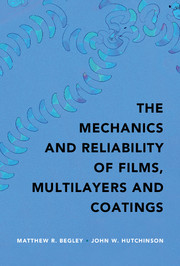Book contents
- Frontmatter
- Contents
- Acknowledgements
- Notation
- 1 Introduction
- 2 Key Mechanics Concepts
- 3 Linear Elastic Fracture Mechanics
- 4 Steady-State Delamination of Bilayers
- 5 Steady-State Delamination in Multilayers
- 6 Steady-State Channeling and Tunneling Cracks
- 7 Crack Kinking from an Interface
- 8 Crack Penetration, Deflection or Arrest?
- 9 Edge and Corner Interface Cracks
- 10 Buckling Delamination
- 11 Delamination of Thin Strips (Patterned Lines)
- 12 Delamination in Multilayers Subject to Steady-State Temperatures
- 13 Cracking under Transient Temperature Distributions
- 14 Software for Semi-Infinite Multilayers: Steady-State Delamination
- 15 Software for Semi-Infinite Multilayers: Transient Delamination
- 16 Finite Element Software for Multilayers: LayerSlayer FEA
- 17 Convergence and Benchmarks with LayerSlayer FEA
- Appendix Asymptotic Crack Tip Displacement Fields for an Interface Crack
- References
- Index
13 - Cracking under Transient Temperature Distributions
Published online by Cambridge University Press: 13 July 2017
- Frontmatter
- Contents
- Acknowledgements
- Notation
- 1 Introduction
- 2 Key Mechanics Concepts
- 3 Linear Elastic Fracture Mechanics
- 4 Steady-State Delamination of Bilayers
- 5 Steady-State Delamination in Multilayers
- 6 Steady-State Channeling and Tunneling Cracks
- 7 Crack Kinking from an Interface
- 8 Crack Penetration, Deflection or Arrest?
- 9 Edge and Corner Interface Cracks
- 10 Buckling Delamination
- 11 Delamination of Thin Strips (Patterned Lines)
- 12 Delamination in Multilayers Subject to Steady-State Temperatures
- 13 Cracking under Transient Temperature Distributions
- 14 Software for Semi-Infinite Multilayers: Steady-State Delamination
- 15 Software for Semi-Infinite Multilayers: Transient Delamination
- 16 Finite Element Software for Multilayers: LayerSlayer FEA
- 17 Convergence and Benchmarks with LayerSlayer FEA
- Appendix Asymptotic Crack Tip Displacement Fields for an Interface Crack
- References
- Index
Summary
The previous chapter dealt with steady-state, time-independent temperature distributions which induce stress in a body due, for example, to interruption of heat flow across a preexisting crack or to thermal expansion and/or conductivity mismatches across material interfaces. This chapter deals with problems where transient (time-dependent) temperature distributions induce stresses in a body and, in turn, how these stresses can cause cracking or interface delamination.
A simply connected solid with uniform properties which is unconstrained at its boundaries experiences no stress under temperature distributions imposed on its surface once the temperature distribution ceases to change and steady-state conditions are attained. However, during the transient period while the temperature is changing, stresses will generally be induced, and the solid may be susceptible to cracking.
The first set of examples considered in this chapter deals with an unconstrained uniform semi-infinite solid having an initial uniform temperature which is suddenly subject to a temperature change imposed on its entire free surface. Cold shock, with cooling imposed, induces transient tensile stresses acting parallel to the surface with the potential to causemode I cracking perpendicular to the surface, as well as mixed-mode delamination cracking on a weak interface parallel to the surface. When a sudden increase in surface temperature is imposed, the resulting hot shock produces compressive stresses parallel to the surface such that subsurface mixed-mode delamination is again a possibility if weak interfaces exist parallel to the surface.
The second example again considers a uniform semi-infinite solid at an initial uniform temperature, but in this case localized hot shock is considered with a higher temperature suddenly imposed over a local region on its surface. The stress field is more complicated in this case with both tensile and compressive components such that various modes of cracking must be considered.
- Type
- Chapter
- Information
- The Mechanics and Reliability of Films, Multilayers and Coatings , pp. 174 - 187Publisher: Cambridge University PressPrint publication year: 2017



